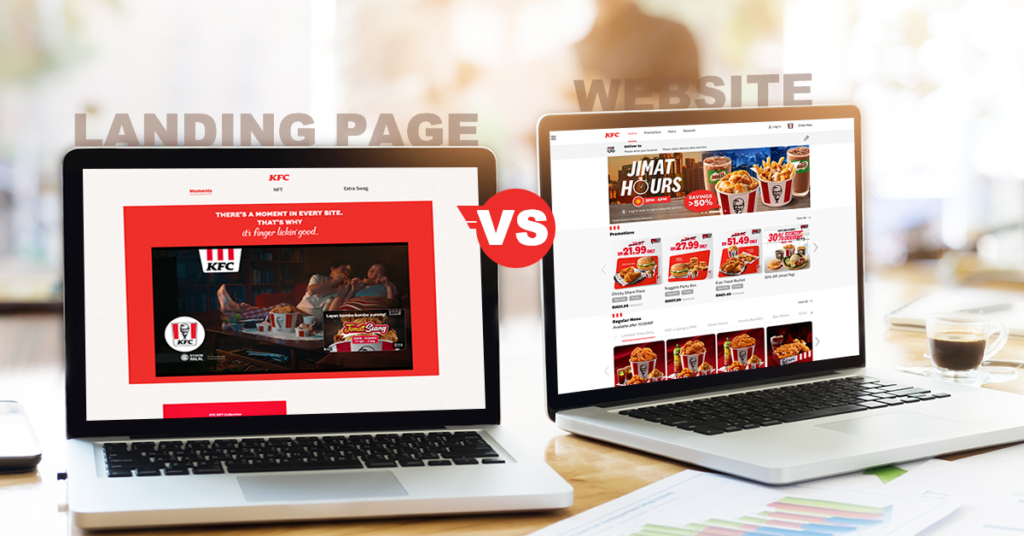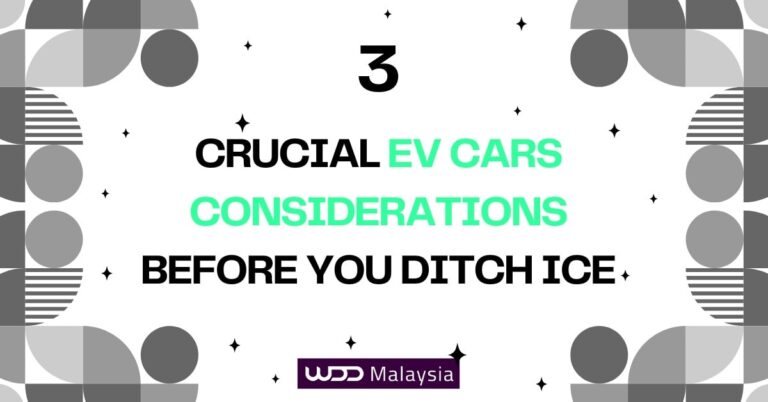
In the contemporary digital marketing landscape of Malaysia, SME companies are keenly aware of the pivotal role landing pages play in their digital outreach. With the global thrust towards a more integrated digital marketplace, it’s no longer enough for a business to have a mere website. Rather, creating a new website and separate landing pages is becoming the norm for those serious about optimising their online visibility.

Photo by KFC
What is a Landing Page?
A landing page is a specific type of web page designed with a singular focus: to convert visitors into leads or customers. Unlike other pages on your website, a well-designed landing page follows specific principles rooted in human psychology and user experience. The primary objective of a landing page is to drive a single, focused action, known as a Call to Action (CTA). This could be anything from signing up for a newsletter to making a purchase. By eliminating distractions and honing in on one clear message, landing pages are highly effective in guiding visitors towards taking the desired action, making them an indispensable tool in online lead generation campaigns.
What are Landing Pages vs Websites (web pages)?
In the vast expanse of the digital realm, landing pages serve as focal points, designed to capture a visitor’s attention and direct them towards a specific action. But what distinguishes landing pages from the myriad of other pages on a website?
A website, in its entirety, is akin to a digital brochure representing a company’s online presence. It encompasses a range of pages, each serving various purposes – from sharing the brand’s history, showcasing its products or services, to providing contact information and more. Conversely, landing pages are specialised entities within this web ecosystem. Each landing page is crafted with a singular objective in mind, whether it’s to promote a limited-time offer, gather user data through a subscription form, or introduce a new product.
Unlike the comprehensive nature of a website that seeks to inform and engage its visitors holistically, landing pages are all about conversion. They strip away the extraneous elements, focusing solely on driving the visitor toward that one predefined action. This doesn’t mean that landing pages operate in isolation. In fact, they often work hand in hand with a company’s main website. A visitor might discover a brand through its website but be directed to a specific landing page when they click on a promotional banner or an advertisement. This synergistic relationship between a website’s broader informational scope and the laser-focused objective of landing pages ensures that businesses can cater to both the explorative and decisive modes of their potential customers.
When considering the cost and scope of creating different types of business websites in Malaysia, it’s important to note that a one-page website can be a cost-effective option for small businesses while still serving specific marketing purposes.
Simply put, a landing page is a standalone web page crafted with a specific purpose in mind. Unlike standard websites which may have a multitude of functions, a landing page is typically dedicated to a single call to action (CTA) or value proposition. When a Malaysia SME company dives into the digital market, these pages often become their strongest tool to convert visitors, generate leads, and engage potential customers.

Why More Landing Pages? – Creating separate landing pages
The topic of how many landing pages a site should feature frequently emerges in digital strategy meetings, especially among the burgeoning Malaysia SME sector. While there’s no one-size-fits-all answer, the underlying premise is that more landing pages can equate more leads to better-targeted and more effective digital outreach. Here’s a deeper dive into why multiple landing pages could be beneficial:
Tailored User Experience
Think of each landing page as a unique doorway into the business. By creating separate landing pages, companies can provide a personalised user journey based on specific products, services, or campaigns. This level of customization enhances user engagement and increases the likelihood of taking the desired action.
Improved Organic Search Visibility
Search engines prioritise relevancy. When a business has multiple landing pages, each optimised for specific keywords and topics, it casts a wider net in search engine results. This increases the chances of capturing organic traffic from varied user queries.
Segmented Marketing Campaigns
With multiple landing pages, businesses can run segmented advertising campaigns. This means a company could advertise a particular product or service to a specific demographic using various ads on a dedicated landing page, leading to higher conversion rates.
Additionally, a single landing page can be a cost-effective and functional option for small businesses or specific marketing campaigns, serving as an efficient sales funnel.
A/B Testing & Optimization
More landing pages allow businesses to experiment. Through A/B testing, where different versions of a page are presented to users, companies can determine which designs, CTAs, or content development strategies are most effective. This iterative approach is crucial for continuous improvement.
Targeting Different Buyer Personas
Not all customers are the same. Some might be at the initial stages of discovering a product, while others might be ready to purchase. By having multiple landing pages, a company can cater to different buyer personas, ensuring that messaging and CTAs are appropriately aligned with each visitor’s stage in the buying cycle.
Harnessing Diverse Traffic Sources
When businesses share relevant content across various platforms, from social media sites to email marketing campaigns, they can direct traffic from various factors to specific landing pages tailored to those audiences. For instance, a visitor from a LinkedIn campaign might land on a different page than one from an Instagram ad, each optimised for the respective platform’s audience.
Minimising Bounce Rates
One of the challenges businesses face is high bounce rates high converting landing pages, where visitors leave without engaging. Multiple landing pages, tailored to specific user intents, can mitigate this. If a visitor finds exactly what they’re looking for upon arrival, they’re less likely to bounce.

In the world of digital marketing, the importance of a landing page can’t be understated. Landing pages, often referred to as “lead gen pages”, are pivotal in capturing user interest and driving conversions. But what elements make up a truly effective landing page? Here’s an in-depth look:
1. Clear Value Proposition
Every landing page must have a clear and compelling value proposition. It’s essentially your pitch to the visitor, succinctly explaining what you offer and why it’s beneficial. This should be the front page website focal point, ensuring visitors understand your offering within seconds of landing on the page.
2. Relevant Content
Users arrive at a landing page with specific expectations, often shaped by the ad or link they clicked. Ensure that the content is relevant to their expectations and addresses their needs directly. This increases trust and improves the chances and quality of conversion.
3. Compelling Call to Action (CTA)
The CTA is arguably the most critical element on the page. It instructs the user on the next steps, whether it’s filling out a form, signing up for a newsletter, or making a purchase. The CTA should be clear, concise, and prominently placed, free from distractions.
4. Seamless User Experience
Users shouldn’t struggle when navigating your landing page. A professional design, beautifully designed layout, intuitive flow, and quick load times contribute to a seamless user experience, encouraging visitors to stay longer and interact.
Unlike regular web pages, a landing page should have a professional design to ensure it effectively converts visitors. As such, it should be a standalone web page, devoid of extraneous links or navigation options that could divert the user’s attention. The focus should be solely on the core message and desired action.
6. Engaging Design Elements
Visual elements, including high-quality images, infographics, and videos, can enrich the user experience. When done right, they not only make the page aesthetically appealing but also help convey the brand’s message more effectively.
Incorporate testimonials, reviews, or case studies to add credibility. Social proof assures prospective customers that others have benefited from what you’re offering, building trust.
8. Minimise Distractions
Keep the web design clean and free of unnecessary clutter. Fewer links, for instance, can ensure that users remain focused on the primary action you want them to take.
9. Lead Data Capture
For many companies, the primary goal of a landing page is lead generation. Ensure there’s a mechanism, typically a form, to capture essential lead data like contact info. However, don’t make these forms too lengthy; you want to strike a balance between gathering data and not deterring users.
With a significant portion of users accessing sites via mobile devices, ensuring your website or landing page is mobile-friendly is paramount. A well-optimised landing page will automatically adjust to various screen sizes, providing an optimal viewing experience.
11. Integration with Marketing Tools
Modern landing page builders often allow integrations with marketing tools. This makes it easier to track performance metrics, automate follow-ups, and streamline various marketing campaigns.
Additionally, our landing page and website design packages come with free Google Analytics setup to help clients track performance, visitor behavior, and conversions effectively.
12. Consistent Branding
Your landing page, while standalone in function, should still resonate with your overall brand in terms of colours, fonts, and messaging. Consistency instils trust and makes users feel secure while interacting with your site.

Affordable Landing Page Design Solutions
At WDD Malaysia, we understand that small and medium-sized enterprises (SMEs) in Malaysia often operate with limited budgets. That’s why we offer affordable landing page design solutions tailored to meet your specific needs and goals. Our landing page design services are crafted to provide a high return on investment (ROI) by improving conversion rates. Our team of experienced web designers and digital marketers will collaborate with you to create a well-designed landing page that not only looks great but also performs exceptionally well. With competitive pricing and a focus on delivering results, our landing page design and services ensure that you get the most value for your investment.
Common Challenges Faced by SMEs in Malaysia
Creating an effective online presence is no small feat, especially for SMEs in Malaysia. One of the most significant challenges is developing a well-designed landing page that successfully converts visitors into customers. Many SMEs struggle to create landing pages that resonate with their target audience, leading to low conversion rates. Additionally, limited budgets can make it difficult to invest in high-quality landing page design services. At WDD Malaysia, we recognize these challenges and offer affordable solutions to help SMEs overcome these obstacles. Our landing page design services are specifically designed to address these issues, providing you with the tools and expertise needed to create high-converting landing pages that drive your business forward.
Tools for Landing Page Creation
In the world of digital marketing, the importance of a landing page can’t be understated. Landing pages, often referred to as “lead gen pages”, are pivotal in capturing user interest and driving conversions. But what elements make up a truly effective landing page? Here’s an in-depth look:
Intuitive Drag-and-Drop Interfaces
Most landing page builders prioritise ease of use. They offer drag-and-drop interfaces, enabling users to effortlessly design pages by placing elements like images, forms, and CTAs wherever they see fit. This intuitive approach ensures that even those with limited technical know-how can produce beautifully designed, functional landing pages without the need for a developer. This flexibility has led to an increasing number of businesses, from startups to well-established companies, harnessing these tools to optimise their digital presence.
Integration and Optimization Features
Modern landing page tools don’t just stop at design; they offer a suite of features geared towards optimization and integration. Many allow seamless connections to email marketing platforms, CRM systems, and analytics tools. This interconnectedness ensures that data flows smoothly across platforms, allowing businesses to track user behaviour, A/B test different elements, and tailor their advertising campaigns accordingly. Additionally, many tools prioritise SEO features, ensuring that the created pages rank well on search engines, driving organic traffic. Some even offer built-in A/B testing, so companies can continually refine their pages for maximum conversion.
Cost-Effective Solutions with Scalability
One significant advantage of using landing page builders is the cost-effectiveness. Many offer tiered pricing, accommodating everything from solo entrepreneurs to large corporations. As a business grows, these platforms can scale accordingly, providing more features and capabilities. This scalability ensures that companies don’t have to continually switch tools, but instead, they can grow with the platform, ensuring consistency in their landing pages and a continuous understanding of the tool’s features. Whether a SME company in Malaysia or a multinational corporation, these tools offer a solution that can adapt to changing business needs.

Driving Traffic to Your Landing Pages
Once businesses have their beautifully designed and well-optimised landing page ready, the next step is to drive traffic. Driving traffic to your landing pages is imperative. However, the mere creation of a well-optimised landing page is not the endpoint. It serves as a foundation upon which to build and direct traffic. Accumulating consistent and accurate data is pivotal in this process. By analysing this data, businesses can gauge where their traffic is coming from and adjust their strategies accordingly to maximise ROI.
Harnessing Data from Various Channels
Every marketing channel, be it social media sites, search engines, or email campaigns, provides a treasure trove of data. This data provides insights into user behaviours, preferences, and pathways. For instance, analysing data from social media campaigns might reveal which posts or ads generate the most clicks to your landing pages.
Similarly, data from search engines can give businesses an understanding of which keywords are driving the most organic traffic to their landing pages. By harnessing this data, businesses can refine their advertising campaigns, ensuring they target potential customers more effectively.
The Importance of Continuous Data Analysis
In the ever-evolving digital landscape, user behaviours and market trends change rapidly. This makes continuous data analysis crucial. By regularly assessing the data, businesses can spot emerging patterns or shifts in behaviour. Perhaps a landing page that was previously attracting vast amounts of traffic from a particular social media platform starts seeing a decline.
By spotting this early through data analysis, strategies can be adjusted to address the issue. Moreover, continuous data scrutiny helps in A/B testing, where businesses can tweak various elements of a landing page to see which version garners the best results. In essence, data is the compass that guides businesses, ensuring their landing pages remain effective and relevant in their clear goal of attracting and converting visitors.

The Impact on Malaysia's SME Landscape
Malaysia’s SME landscape has experienced transformative changes, with digitalization playing a pivotal role. With the surge of internet users in the region, having an online presence has become crucial for businesses of all sizes. A company’s website is no longer just a digital calling card; it’s a dynamic marketplace, a platform for brand stories, and an essential tool for driving conversions and sales. Amidst this transformation, the strategic use of landing pages has emerged as a game-changing tactic for SMEs.
While a business’s website serves as the central hub, detailing its services, products, company history, and other pertinent details, it can sometimes overwhelm a visitor with too much information. This is where the precise and targeted nature of a landing page steps in. Instead of navigating a complex web of pages, potential customers are greeted with a single, focused message or offer on a single landing- page. It’s this laser-focused approach that makes landing pages so effective in driving specific actions, be it signing up for a newsletter, buying a product, or registering for a webinar.
For many SMEs in Malaysia, the combined power of a well-designed website and targeted landing pages offers a competitive edge. The website draws visitors in, building brand awareness and trust, while specific landing pages convert these visitors into loyal customers. Moreover, as SMEs often operate with limited marketing budgets, landing pages provide a cost-effective way to test different marketing strategies, offers, and messages. By analyzing how users interact with these landing pages, businesses can refine their approach, ensuring they resonate with their target audience. In essence, the harmonious integration of websites and landing pages is revolutionising the digital strategies of SMEs in Malaysia, equipping them with the tools to thrive in an increasingly competitive market.




